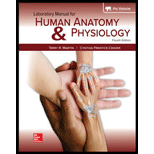
Concept explainers
Muscles that move the thigh at the hip joint have origins on the
a. pelvis.
b. femur.
c. tibia
d. patella.
Introduction:
Lower limb consists of the largest muscles. Most muscles that act on femur originate on the hipbone.
Answer to Problem 1PL
Correct answer:
The correct answer is option (a) Pelvis.
Explanation of Solution
Explanation/justification for the correct answer:
Option (a) Pelvis. The muscles that move the thigh at the hip joint have their origins on the pelvis. Those muscles attached on the anterior pelvis act to flex the thigh at the hip joint, those attach at the posterior pelvis act to extend the thigh at the hip joint, those attached at the lateral side of the pelvis act as abductors and rotators of the thigh at the hip joint, and those attached on the medial pelvis act as adductors of the thigh at the hip joint. So, the correct answer is option (a).
Explanation for incorrect answer:
Option (b) Femur. Femur is the thigh bone. The muscles that move the thigh at the hip joint originate at pelvis and the insertion I usually on the femur. So, this is an incorrect option.
Option (c) Tibia. Tibia is one of the leg bones. The leg has two bones: a thick strong tibiaon the
medial side and a slender fibula on the lateral side. Tibia and fibula extend from the knee to the ankle. So, this is an incorrect answer.
Option (d) Patella. The patella or kneecap is a roughly triangular sesamoidbone embedded in the tendon of the knee.So, this is an incorrect answer.
Want to see more full solutions like this?
Chapter 25 Solutions
Laboratory Manual For Human Anatomy & Physiology
- Which of the following does NOT have striated muscles? a. abdomen b. arm c. hamstring d. liverarrow_forwardJIll reflected the skin from the back or her donor, revealing a muscle that was attached medially to the spinous process of the cervical and thoracic vertebrae and laterally to the scapular spine. What muscle did jill expose? A. The trapezius B. The latissiums dorsi C. THe levator scapulae D. Rhomboid major and minorarrow_forwardThe function of the biceps femoris is to A. flex the hip and ankle. B. extend the thigh and flex the leg. C. flex the thigh and extend the leg. D. flex the thigh (with no action at the leg). E. adduct the thigh and extend the knee.arrow_forward
- When the left and right ________ contract, they flex the head and neck. a. sternocleidomastoid b. longissimus group c. splenius d. rectus abdominisarrow_forwardA muscle that assists the muscle primarily responsible for a given action is a __________. a.Synergist b.Antagonist c.Originator d.Levator A muscle whose name ends in the suffix -gluteus would be found attached to the ___________. a.cheek b.tongue c.buttock d.chestarrow_forwardExplain why the adductor longus muscle is a more effective hip adductor than the pectineus?arrow_forward
- Both the gastrocnemius and _____ muscles insert on the heel by way of the calcaneal tendon:- a. semimembranosus b. tibialis posterior c. tibialis anterior d. soleus e. plantarisarrow_forwardWhich of these muscles does not contribute to the rotator cuff? a. the supraspinatus b. the infraspinatus c. the subscapularis d. the teres major e. the teres minorarrow_forwardWhat are the muscles of the pharyngeal arches and derivatives: a. branchiomeric muscles b. none of the above c. somatic muscles d. visceral musclesarrow_forward
 Fundamentals of Sectional Anatomy: An Imaging App...BiologyISBN:9781133960867Author:Denise L. LazoPublisher:Cengage Learning
Fundamentals of Sectional Anatomy: An Imaging App...BiologyISBN:9781133960867Author:Denise L. LazoPublisher:Cengage Learning Medical Terminology for Health Professions, Spira...Health & NutritionISBN:9781305634350Author:Ann Ehrlich, Carol L. Schroeder, Laura Ehrlich, Katrina A. SchroederPublisher:Cengage Learning
Medical Terminology for Health Professions, Spira...Health & NutritionISBN:9781305634350Author:Ann Ehrlich, Carol L. Schroeder, Laura Ehrlich, Katrina A. SchroederPublisher:Cengage Learning



